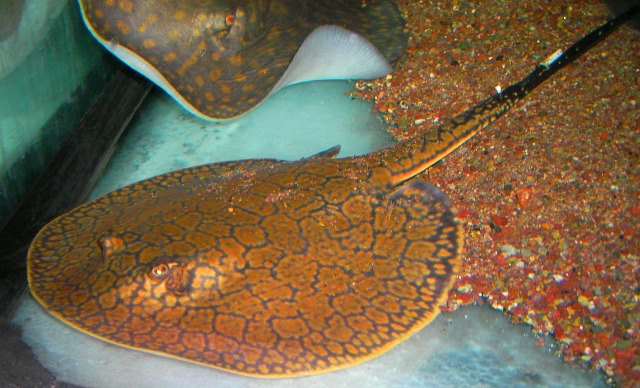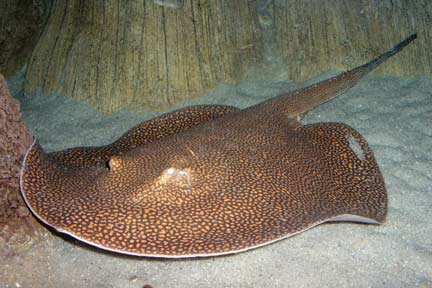Fauna 68: Ocellate river stingray
Common Name: Ocellate river stingray
Scientific Name: Potamotrygon motoro
Local Name: Motoro Sting Ray
Origin: South America. Uruguay, Paraná-Paraguay, Orinoco, and Amazon River basins.
Life Span: up to 20 years
Temperament: Timid. A very peaceful specie but is prone to bullying. It is, however, predatory and may eat smaller tankmates.
Tank Compatibility Issue (for both Flora and Fauna):These rays need an aquarium with an lot of open space to swim on as they like all cartilaginous (lack gas bladders) fish need to in constant movement. A minimum aquarium size for motoro sting rays can be said to be 100G. The water needs to be kept clean and good filtration and regular water changes are a necessity. They are sensetive to of ammonia, nitrite, and nitrate as well as many other chemicals and special cary should there for ne taken befor eusing chemicals and medicines in aquariums containing Motoro sting rays.
Freshwater/Brackish/Marine: Freshwater
Water pH: preferably 6.7
[B]Water Hardness:Softer (less than 10 DH), more acidic (pH 7.0 or lower) is encouraged.
Temperature: 24 - 26 °C ( 75.2 - 78.8 °F )
Schooling/Non-schooling: Non-schooling
Common Illness/Problems: River stingrays are susceptible to ich and other tropical freshwater maladies; what's more they frequently harbor monogenic fluke and internal worm problems. Treating for infectious and parasitic disease is problematical with freshwater rays. Though many other authors encourage the use of copper-based, organophosphate (e.g. Dylox), and other commercial nostrums, I warrant against this. These fishes are quite sensitive to poisoning by such treatments, and frequently are killed by the "cure".
Growth: slow
Length/Size: 100 cm WD / 39 inches WD 15 Kg ; Usually around 30cm/1' across in disc size.
Difficulty: Intermediate-Difficult
General Description: The body of the ocellate river stingray is an oval disc, with a greyish-brown upper surface patterned with distinct yellow-orange spots, and a white underside. While the ocellate river stingray is a beautiful species, it is much feared for the single spine borne at the tip of the robust tail, which is capable of delivering a painful sting.
Ocellate river stingrays are sometimes kept in captivity, with requirements similar to other members of Potamotrygon. It is one of the most common species of Potamotrygon in the aquarium.
Other Important Information: The motoro stingray lives up to its name and has a very sharp and venomous sting on its tail. Although it will only attack in defense, take precautions when handling this animal. Many people who have kept these stingrays say that they are extremely friendly and full of character - even so always respect this animal and take precautions just in case. They don't like pH fluctuations, nitrites must be zero and nitrate very low. This means plenty of freshwater and lots of water changes. Another tip: don't let your ray go hungry, the 'as much as they will eat in 2 minutes' guide to keeping common tropical fish goes out the window, especially when they are young.
Other species of freshwater sting rays:
(Species of Interest to Aquarists)
Himantura chaophrayaFreshwater Whipray
Potamotrygon henlei Bigtooth River Stingray
Potamotrygon cf. reticulatus Red-Caqueta
Potamotrygon castexi Vermiculate River Stingray
more stingrays:
The Stingray Source - Potamotrygons of South America
References:
Motoro Sting Ray - Potamotrygon motoro
Ocellated River Stingray - Potamotrygon motoro
Motoro Stingray
Ocellate River Stingray - Potamotrygon Motoro
Freshwater Stingrays, Family Potamotrygonidae
Ocellate river stingray - Potamotrygon motoro - Information - ARKive
The Stingray Source - Potamotrygons of South America
Results 121 to 130 of 193
-
07-06-2010, 03:30 PM #121
Last edited by scorpia; 07-06-2010 at 03:37 PM.
-
07-06-2010, 04:52 PM #122
Flora #84: Marimo Algae

Giant Marimo Algae
Common Name: Cladophora ball, Lake ball,Tribbles or Moss Balls
Scientific Name: Aegagropila linnaei
Local Name: Moss ball
Origin: Iceland, Scotland, Japan and Estonia.
Native to Philippines (Y/N): N
Light Level: Low- high (very adaptable)
CO2 Requirement (Y/N): N
Fertilizer Requirement (Y/N): N
Life Span: longest record to have lived more than 100 years.
Freshwater/Brackish/Marine: Freshwater
Water pH: 6.8-7.5 some could tolerate up to 9
Temperature: 68-82F (20-28C)
Water Hardness: Moderate hardness
Common Illness/Problems/Threats: Dim light, copper, other plants, debris
Growth: Slow (5 mm per year)
Length/Size: 20-30 cm (8-12 in.)
Difficulty: Easy
Tank Position: Foreground- Midground; Can be kept separately in bowls.
Water Current/Movement Issues: free floating;As it is photosynthetic, it floats or sinks in the water in response to columns of light, and actually rolls around on the bottom of the aquarium.
General Description:
Aegagropila linnaei is not a plant, but rather an alga. As a result, this is perhaps one of the very few algae species which are desired in the aquarium. This is a sponge-like alga which are shaped into spheres by constant moving by water currents that develop the ball on all sides. Unlike other algae, this will not spread throughout the aquarium and need not be feared. Even in good conditions, these algae balls are very slow growing, but higher light and nutrient rich conditions will of course hasten growth to a degree.
Other Important Information:
Marimo Moss Ball is actually a type of algae scientifically called Aegagropila linnaeii in 1843, which was subsequently renamed as Cladophora aegagropila in 1849. In 2002, it was returned to its original name of Aegagropila linnaei after extensive DNA research that proved it's not a true Cladophora species.
References
Reviews - Marimo balls - Powered by ReviewPost
Japanese moss balls, Cladophora aegagropila, with pictures
Moss Balls/Marimo Balls/Tribbles (Cladophora aegagropila)
http://www.greenculturesg.com/articl...07_marimos.pdf
Marimo (moss ball) for sale - PALHS Online Community Forum
Pet Solution Inc.: Marimo Algae (moss ball)
Marimo - Wikipedia, the free encyclopediaLast edited by scorpia; 07-06-2010 at 04:56 PM.
-
07-07-2010, 08:53 PM #123
Fauna # 69: Fire Eel

Common Name: Fire Eel
Scientific Name: Mastacembelus erythrotaenia
Local Name: Fire Eel
Origin: Southeast Asian countries including Borneo, India, Malaysia, Myanmar (Burma), Sri Lanka, Sumatra, and Thailand
Life Span:
Temperament: Semi-aggressive
Tank Compatibility Issue (for both Flora and Fauna): Should only be kept with fishes of the same size or larger. They do not get along with other Fire Eels.
Freshwater/Brackish/Marine: Freshwater
Water pH: 6-7.5 (7.0)
Water Hardness: 6-20 dH (10)
Temperature: 24°C - 28°C / 72-79 F
Schooling/Non-schooling: Non-Schooling
Common Illness/Problems: Fire eels can easily abrade themselves. Mastacembelid eels are susceptible to fungal infections or bacterial infections after scraping their bellies or fins.
Growth: slow-moderate
Length/Size: Up to 24"
Difficulty: moderate but not for beginners
Water Current/Movement Issues:
General Description: The fire eel is an extremely elongated fish with a distinctive pointed snout and underslung mouth. The body is laterally compressed particularly at the rear third where it flattens as it joins the caudal fin and forms an extended tail. It is part of a group of fishes called spiny eels that also includes Tire Track and Peacock eels. The group gets the "spiny" part of its common name from the many small dorsal spines that precede the dorsal fin. The fire eel's base colouring is dark brown/grey, while the belly is generally a lighter shade of the same colour. The pattern varies from fish to fish. Usually several bright red lateral stripes and spots mark the body. The red markings vary in intensity depending on the age and condition of the specimen. Usually the markings are yellow/amber in juvenile fish, changing to a deep red in larger ones. Often the anal, pectoral, and dorsal fins have a red edging.
Other Important Information: The name "eel" is a reference to the body shape;The Fire Eel is not a true eel, but an elongated freshwater fish with spines. It is dark brown in color with a lighter belly and several red stripes along the body. As the Fire Eel is a burrowing fish a fine gravel substrate is ideal. This particular fish is best kept as the only Fire Eel in the tank with other larger fish. As with any long slender fish, a tight aquarium lid is recommended to prevent escape.
References
Profile For Fire Eel Or Mastacembelus Erythrotaenia From Bala Shark Bay
Fire Eel info
Fire Eel | Interesting Animals
http://www.fishbase.org/summary/spec...y.php?id=12026
Fire Eel | Mastacembelus erythrotaenia
Fire Eel (Mastacembelus erythrotaenia)
Freshwater Aquarium Fish: Fire Eel
Fire Eel at PETCO
Fire Eel
Fire eel - Wikipedia, the free encyclopedia
-
07-08-2010, 09:26 PM #124
-
07-09-2010, 09:19 AM #125
abi nko pariha sa akong HC g immerse sa nko..then if n spread n cya sa tank..submerse dayun with enough CO2 and light...
BTW mam pia..imong ng tank?? nice set up and sa cichlids inhabitants
-
07-09-2010, 11:05 AM #126
-
07-09-2010, 11:16 AM #127Newbie

- Join Date
- Jul 2010
- Gender

- Posts
- 1
 aquatic plants
aquatic plants
hi. i'm a new planted tank hobbyist. would anyone know where i can buy riccia fluitans and other bushy plants in metro manila? I'm interested in the Amano-type of plant landscaping. thanks.
-
07-09-2010, 12:37 PM #128
sa cartimar or tendecitas. hehehe soery dont realy knw the speling
-
07-09-2010, 10:09 PM #129
 brad madkc, isn't immerse and submerge/submerse synonymous?
brad madkc, isn't immerse and submerge/submerse synonymous?
Marimo BTW is not that demanding when it comes to light and CO2... but wala pakoy ingun-ani... base lang sa mga gipan research nako... I really wanna have one...
The tank in the picture isn't mine ... wish it was!!! The color combination really matched the color of the yellow prince.
wish it was!!! The color combination really matched the color of the yellow prince.
Pareho ta brad! idol ayo namo ni sako partner... sens pa ang nasa amo but were planning to but the nicer ones like delhezi and ornate... kung makakita mi platinum we'll surely go for it kay rare breed lang jud na siya
idol ayo namo ni sako partner... sens pa ang nasa amo but were planning to but the nicer ones like delhezi and ornate... kung makakita mi platinum we'll surely go for it kay rare breed lang jud na siya 
Last edited by scorpia; 07-09-2010 at 10:16 PM.
-
07-13-2010, 08:02 AM #130
balikon lang nako post:

naa 'mo endemic freshwater fishes in the philippines? if naa, post lang diria..apila lang sad shrimps.. i know nga naa ta daghan sa pilipinas pero morag anam-anam na nga nawagtang..
Advertisement
Similar Threads |
|










 Reply With Quote
Reply With Quote



